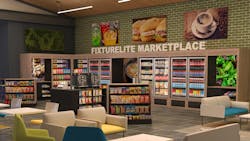It is an idea that Fixturelite co-founder Steve Orlando has been pitching for years on the trade show floor, in the Micro Market Design quarterly newsletter from Vending Market Watch, and basically, to any operator who would listen. “For a long time, we have been suggesting that if an operator is going to provide an exceptional breakroom, a true destination, operators need to ask their clients to participate in the cost,” said Orlando. “Mostly, due to fear of not getting the account, many salespeople fear pitching the idea.”
Employers are willing to pitch in
In the changing landscape of today’s workplace, Orlando’s idea is more relevant than ever. Leading employers are recognizing the necessity of investing in their spaces and are relying on experts, like micro market operators, to help them create magical breakrooms. “To accomplish their objective – to create a collaborative and comfortable environment – employers are willing to pitch in,” Orlando said.
Key word: Flexibility
In a 2022 CNBC interview, Scott Dussault, the CFO of HR tech company Workhuman, spelled out the willingness of companies to spend more on less space. “The concept of 9-to-5 in the office, five days a week, is gone – the keyword is going to be flexibility,” said Dussault.
For many companies, that means retrofitting offices to meet this new normal and employee demands, while also investing to make sure connections are still being made efficiently – efforts that could mean spending more money even if square footage or leases are adjusted.
“I’m not so sure it’s going to be a cost negative,” Dussault said. “I’m not sure if people are going to take less real estate; they’re just going to change the way that real estate works.”
Ask the question
“Right off the bat, operators should find out what a business’s budget is for the micro market installation – or better yet, rejuvenation – when you already have the account,” said Troy Geis, Orlando’s co-founder at Fixturelite, the industry’s leading supplier of micro market retail solutions, destinations and experiences. “Fearlessly find out what the business's budget is for the project – find out what the business is willing to do. How far are they willing to go to create a destination to encourage their employees to come back to the office?”
Some unique elements
“There are some unique and compelling elements that are needed in today’s workplace, and they go beyond a simple micro market of the past. We are doing movement of the market into the space, adding custom seating, collaboration areas, and even acoustical elements, now more than we've ever done before,” Geis said. “Employees need privacy and that means phone booths and sound restrictive spaces – essential elements that work into and around the collaborative areas – essential elements that clients will be willing to pay for.”
A whole new world
“You also have a certain number of employees that because of their job role, do not have the option of working in a hybrid situation. It becomes critically important for an employer to do something very special with the refreshment space so that they do not feel slighted, or even resent having to come into the office,” said Orlando. “Fighting resentment is a whole new world for employers.”
Collaboration destination
Dussault said he sees the office becoming what he calls a “collaboration destination,” part of a hybrid environment in which you might work from home on days when you’re catching up on work or emails, while the office serves as a space that is “all about connection.”
“You’re going to see a lot more open spaces, collaboration spaces, conference rooms, meeting rooms and break areas where people can sit and get together,” he said. “It’s going to be focused on connection, which I think is positive, and it is evolution – it’s going to be about making those connections more meaningful.”
One bucket to another
That would mean investing more in things like a gym, where employees could take a physical break, or other spaces that would provide a place to take an emotional break or meditate, Dussault said, and that this could result in costs shifting “from one bucket to another.”
Your bucket
One of those “buckets” should belong to the micro market operator who is presenting ideas that will dazzle the client – ideas that create a blueprint for the open, collaborative and comfortable breakrooms that leading employers are seeking. “The Fixturelite Collections are the perfect starting point, and operators can use them as a canvas to create a sensational destination, one that their clients will be willing to invest in,” Orlando noted. “It’s about sound, light, texture, comfort and ambiance. We can help create an environment that is a destination, and we are doing it every day.”
“Best of all – if it is well presented, the client will pay for it, or at least contribute in some way, and we can help with that with our design and presentation tools,” Orlando added.
Let Fixturelite show you how to use design to motivate your clients to invest in their space. Visit www.fixturelite.com.
About the Author

Bob Tullio
Bob Tullio is a content specialist, speaker, sales trainer, consultant and contributing editor of Automatic Merchandiser and VendingMarketWatch.com. He advises entrepreneurs on how to build a successful business from the ground up. He specializes in helping suppliers connect with operators in the convenience services industry — coffee service, vending, micro markets and pantry service specifically. He can be reached at 818-261-1758 and [email protected]. Tullio welcomes your feedback.
Subscribe to Automatic Merchandiser’s new podcast, Vending & OCS Nation, which Tullio hosts. Each episode is designed to make your business more profitable.
